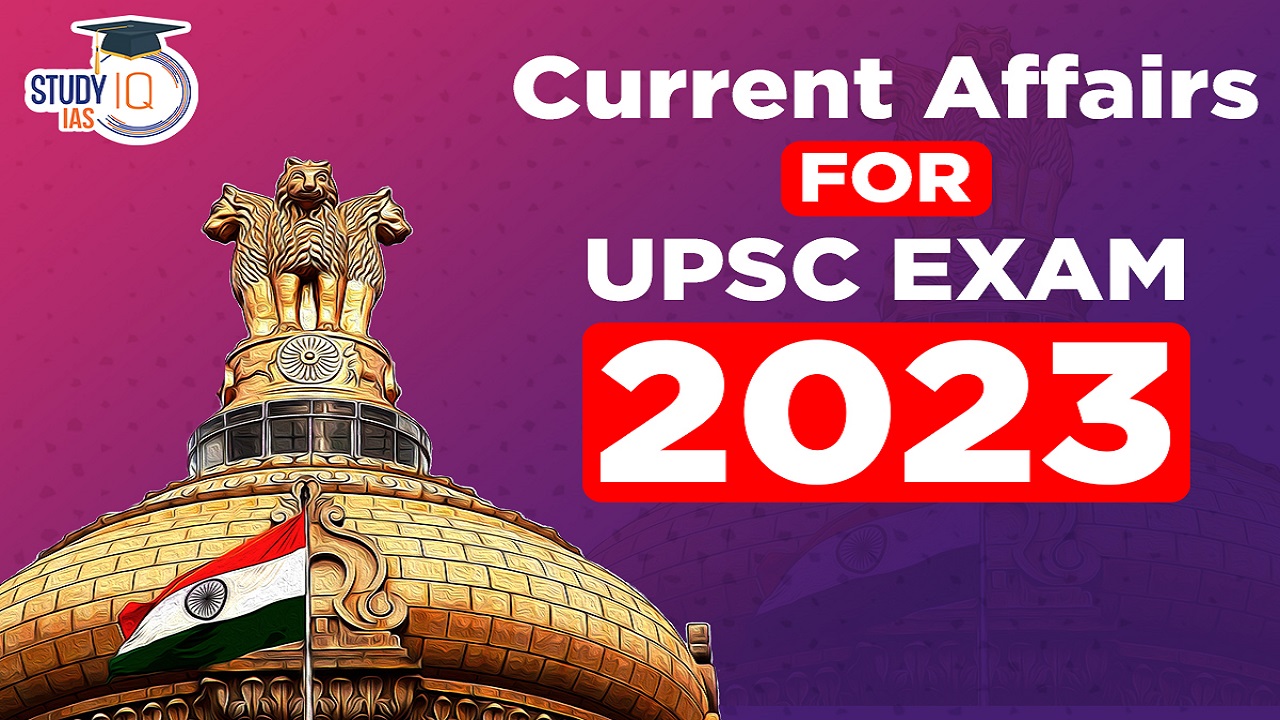Current Affairs 17th July 2023 for UPSC Prelims Exam
NRI, PIO and OCI
Context: The Delhi high court quashed an order by the union government revoking the Overseas Citizenship of India (OCI) status of Sweden-based academic Ashok Swain.
The Concept of NRI, PIO and OCI
- Non-Resident Indian (NRI) is a residential status granted to an Indian citizen with an Indian passport who resides in a foreign country for work/business or education.
- Person of Indian Origin (PIO) is defined as a citizen of any country other than Bangladesh or Pakistan who
- held an Indian passport at any time,
- was a citizen of India by virtue of the Indian Constitution or the Citizenship Act, 1955, or
- is the spouse of an Indian citizen or a PIO.
- An Overseas Citizen of India (OCI) is a person who is technically a citizen of another country but whose ancestors are Indian.
- They were citizens of India on January 26, 1950, or later, unless they are or were citizens of Pakistan, Bangladesh, or such other country.
Difference between NRI & PIO
| Basis | Non-Resident Indian (NRI) | Person of Indian Origin (PIO) | Overseas Citizen of India (OCI) |
| Requirements | To qualify as an NRI, an individual should have spent 182 days or more of a financial year in India, or
Stayed in India for 60 days or more in the year and for a period of 365 days or more in the 4 years preceding the relevant financial year. |
PIO cardholders do not need a visa if they wish to visit India for up to 15 years from the issuance of a PIO Card.
They can stay for up to 180 days In India without registration to FRRO (Foreigner Regional Registration Office). |
An OCI Card Holder can visit India without Visa, anytime during their lifetime.
They can stay in India for any duration without registration to FRRO (Foreigner Regional Registration Office) or local authorities. |
| Voting rights | They enjoy voting rights in India (Physical presence is needed). | They do not have voting rights in India. | They do not have voting rights in India. |
| Eligibility for public offices | They are eligible for public offices. | They are not eligible to hold public offices in India. | They are not eligible to hold public offices in India. |
| Visiting restricted places | They don’t have to take permission to visit restricted places in India. | They need to take permission from the Foreigner Regional Registration Office to visit restricted places in India | They need to take permission from the Foreigner Regional Registration Office to visit restricted places in India |
Current Affairs 15th July 2023 for UPSC Prelims Exam
CRISPR
Context: CRISPR editing has enabled scientists to design wood in which lignin, which must be cleaved and dissolved so fiber production can take place, is more suitable for fiber production.
What is Clustered Regularly Interspaced Short Palindromic Repeats (CRISPR)?
- Gene Editing: Genome editing (also called gene editing) is a group of technologies that give scientists the ability to change an organism’s DNA.
- These technologies allow genetic material to be added, removed, or altered at particular locations in the genome.
- Several approaches to genome editing have been developed. A well-known one is called CRISPR.
- The CRISPR system has generated a lot of excitement in the scientific community because it is faster, cheaper, more accurate, and more efficient than other genome editing methods.
- CRISPR: CRISPR are short DNA sequences found in the genome of prokaryotic organisms such as bacteria, which are reminders of previous bacteriophage (viruses) attacks that the bacteria successfully defended against.
- Cas9 enzyme (part of bacteria’s defence mechanism) uses these flags to precisely target and cut any foreign DNA, thus protecting the bacteria from future attacks by similar bacteriophages.
- The precision of targeting the DNA sequences and then efficiently cutting them is the basis for CRISPR-Cas9 technology, which has been recently demonstrated in editing genes in cells and organisms.
- The CRISPR gene-editing technology had received the Nobel Prize in 2020.
- Use: CRISPR-Cas9 technology has been successfully used for many purposes, including basic studies of gene function, agriculture, and medicine to increase our knowledge of disease processes and their potential future therapies.
- CRISPR Editing for Designing Wood:
- Old Process: Cellulose fibres, often obtained from wood, are a key component in products like paper, packaging, tissues, and hygiene products. But within wood, another polymer called lignin is entangled with cellulose.
- In order to extract the cellulose from wood, the lignin is often broken down with harsh chemicals and separated from the cellulose.
- The more lignin in the wood, the harder it is to isolate the cellulose fibers.
- Use of CRISPR Editing: Now instead than just removing lignin from logs, researchers at North Carolina State University wanted to lower the proportion of lignin from the outset.
- Using the gene-editing tool CRISPR on poplar trees, they modified some of the genes that produce the chemicals that eventually form lignin.
- Using seven gene-editing strategies, each modifying three to six genes, they were able to reduce lignin content up to 35% compared with a nonedited poplar tree when measured after 6 months of growth.
- Importance: Wood edited to have lower lignin content could have several practical benefits:
- Lowering the amount of lignin means increasing the amount of cellulose in the wood, so less biomass is needed to yield the same amount of cellulose.
- Removing lignin from wood would requires less harsh chemicals.
- Removing lignin from wood during the pulping process is energy intensive; wood with less lignin would allow savings of both energy and chemicals.
- Old Process: Cellulose fibres, often obtained from wood, are a key component in products like paper, packaging, tissues, and hygiene products. But within wood, another polymer called lignin is entangled with cellulose.
Amoebiasis
Context: A three-year surveillance study from 2017 to 2020 in Kolkata has found an amoeba pathogen that previously did not cause any amoebiasis (a form of diarrhoea) in humans has now become pathogenic (causing disease).
More on News
- The team of researchers from the Kolkata-based National Institute of Cholera and Enteric Diseases (ICMR-NICED) found that had the amoeba pathogen, Entamoeba moshkovskii (a free-living ameba) had turned pathogenic.
- The researchers also found that infections caused by E. histolytica, which used to be the predominant amoeba pathogen that caused amoebiasis, were decreasing and the newly pathogenic E. moshkovskii was taking its place.
- The researchers identified a few mutations that signify an essential role of the new pathogenic parasite in adapting to the gut environment of humans or in acquiring other enteric pathogens.
- It was also found that infections caused by E. histolytica peaked during the wet season and decreased with the arrival of the dry season.
Genus Entamoeba
- The genus Entamoeba comprises six species, namely Entamoeba histolytica, E. dispar, E. moshkovskii, E. coli, E. hartmanni and E. polecki that live in the human intestinal lumen.
- Infections with Entamoeba species can result in either a harmless colonization of the intestine or invasion of the colonic wall and damage of other host tissues such as liver, lung and brain.
What is Amoebiasis?
- Diarrhoea: Diarrhoea is defined as the passage of three or more loose or liquid stools per day (or more frequent passage than is normal for the individual).
- Diarrhoea is usually a symptom of an infection in the intestinal tract, which can be caused by a variety of bacterial, viral and parasitic organisms.
- Infection is spread through contaminated food or drinking-water, or from person-to-person as a result of poor hygiene.
- Amoebiasis: It is a parasitic infection of the intestines caused by the amoeba Entamoeba histolytica, or E. histolytica.
- Amoebiasis which is caused by Entamoeba histolytica is a global health problem as it is responsible for more than 100,000 deaths per year and is the second leading cause of global death due to protozoa after malaria.
- Types of Amoebiasis:
- Luminal Amoebiasis: This type of amoebiasis hardly shows any clinical signs or symptoms.
- Invasive Amoebiasis: In this type, various symptoms start showing once the parasites invade the body.
- Entamoeba Histolytica: Entamoeba histolytica is a single-celled protozoan that causes intestinal amebiasis as well as extra-intestinal manifestations.
- E. histolytica is a member of the phylum Sarcomastigophora and subphylum Sarcodina, class Lobosa, order Amoebida, and family Entamoebidae.
- Entamoeba histolytica continues to be an important global health issue being the third leading cause of death from parasitic infections.
- There are two forms E. histolytica can take:
- The cyst form, which can survive in the environment for a prolonged period, and
- The trophozoite stage, which is the active and invasive form.
- After the ingestion of the cyst form, trophozoites can be formed, which can invade and penetrate intestinal mucosa destroying epithelial cells and inflammatory cells.
- Spread: It is often transmitted through contaminated food or water.
- Symptoms: Loose stool, abdominal cramping, and stomach pain.
- Treatment: The primary therapy for amebiasis requires hydration and the use of metronidazole and/or tinidazole.
Global Minimum Tax
Context: India has pushed for higher taxes on Multinational Companies’ Excess Profits at G20 Meeting.
What is Global Minimum Tax?
- Definition: It is a global agreement announced by the Organization of Economic Corporation and Development (OECD) to assure big companies like Apple or Amazon pay a minimum tax rate of 15% in order to minimise the chances of avoiding taxation and it has been signed by 136 countries.
- It is estimated that the minimum tax rate would boost global tax revenues by $150 billion annually.
- Application: The global minimum tax rate would apply to overseas profits of multinational firms with 750 million euros ($868 million) in sales globally.
- Governments could still set whatever local corporate tax rate they want, but if companies pay lower rates in a particular country, their home governments could “top up” their taxes to the 15% minimum, eliminating the advantage of shifting profits.
- A second track would allow countries where revenues are earned to tax 25% of the largest multinationals’ excess profit – defined as profit in excess of 10% of revenue.
- Need: The COVID-19 crisis has strained the budget of many governments which now want to discourage multinationals from shifting profits and tax revenues to low-tax countries regardless of where their sales are made.
- Increasingly, income from intangible sources such as drug patents, software and royalties on intellectual property has migrated to these jurisdictions, allowing companies to avoid paying higher taxes in their traditional home countries.
- The minimum tax and other provisions aim to put an end to decades of tax competition between governments to attract foreign investment.
- The deal will encourage multinationals to send back capital to their country of headquarters, giving a boost to those economies.
- Problems:
- Some governments, particularly those of traditional tax havens, are likely to disagree and stop the implementation of the OECD’s tax plan.
- High tax jurisdictions like the EU are more likely to fully adopt the minimum tax plan as it saves them from having to compete against low tax jurisdictions.
- Low tax jurisdictions are likely to resist the OECD’s plan unless they are compensated sufficiently in other ways.
- Even within the EU, countries such as Poland have already tried to stop the adoption of the global minimum tax proposal citing various non-economic reasons.
- Since the OECD’s plan essentially tries to form a global tax cartel, it will always face the risk of losing out to low-tax jurisdictions outside the cartel and cheating by members within the cartel.
- Also, countries both within and outside the cartel will have the incentive to boost investments and economic growth within their respective jurisdictions by offering lower tax rates to businesses. This is a structural problem that will persist as long as the global tax cartel continues to exist.
Comprehensive and Progressive Agreement for Trans-Pacific Partnership (CPTPP)
Context: The U.K. government has signed the accession protocol for the Comprehensive and Progressive Agreement for Trans-Pacific Partnership (CPTPP).
What is Comprehensive and Progressive Agreement for Trans-Pacific Partnership (CPTPP)?
- Definition: It is a free trade agreement (FTA) between Australia, Brunei, Canada, Chile, Japan, Malaysia, Mexico, New Zealand, Peru, Singapore and Vietnam.
- It was signed in March 2018.
- It succeeded the Trans-Pacific Partnership (TPP)after the United States withdrew from the TPP in 2017.
- Members: All 11 countries of CPTPP are members of the Asia-Pacific Economic Cooperation (APEC).
- The U.K. the first new member and first European nation to join the bloc since it was created in 2018.
- Functions: The rights and obligations under the CPTPP fall into two categories:
- Rules: For example, on how countries should make new food safety regulations or whether they can ban the transfer of data to other CPTPP member These are the same for all CPTPP parties (including any new members that may join).
- Market Access: How far each CPTPP member will cut its tariffs, open up its services markets, liberalise visa conditions for business travellers, etc.
- Each member has its own schedules of commitments.
- In some cases, the commitments are offered to all other members, while in others, they are restricted to specific negotiating partners.
- Importance of CPTPP: CPTPP covers virtually all sectors and aspects of trade between member countries to reduce trade barriers and facilitate trade.
- CPTPP is helping to create jobs and strengthen economic relations in member countries.
- CPTPP countries will have a combined GDP of 11 trillion pounds ($13.6 trillion) after joining of Britain, or 15% of global GDP.
- The agreement has market-access commitments in trade in goods, services, investment, labour mobility and government procurement.
- The agreement also establishes clear rules that help create a consistent, transparent and fair environment to do business in CPTPP markets, with dedicated chapters covering key issues like technical barriers to trade, sanitary and phytosanitary measures, customs administration, transparency and state-owned enterprises.
- CPTPP fosters the protection of the environment and labour rights, which are enforceable by dispute settlement, to ensure that CPTPP members do not derogate from their commitments in these areas to increase trade or investment.
- Impact of Britain’s Inclusion in CPTPP:
- Britain is seeking post-Brexit trade wins in geographically distant but faster growing economies.
- As per Britain, exports to CPTPP countries were worth 60.5 billion pounds in the twelve months to end-Sept. 2022.
- Membership of the grouping will add another 1.8 billion pounds each year in the long run, and possibly more if other countries join.
- Britain has agreed a quota on beef imports, but did not agree to lower food standards, under which hormone-treated beef is banned.
- Britain highlighted that 99% of exports to CPTPP would be eligible for zero tariffs, including for on cheese, cars, chocolate, machinery, gin and whisky.
- Tariffs on palm oil from Malaysia will be liberalized and Britain also agreed tariff reductions on bananas, rice and crab sticks following requests from Peru, Vietnam and Singapore respectively.
- Amid the backdrop that China has also applied to join CPTPP, the CPTPP could enable the UK to enhance strategic ties with like-minded countries to protect a free and open Indo-Pacific region.


 Freedom of Press in India, Constitutiona...
Freedom of Press in India, Constitutiona...
 Deputy Speaker of Lok Sabha, Constitutio...
Deputy Speaker of Lok Sabha, Constitutio...
 AIM4NatuRe Initiative for Nature Restora...
AIM4NatuRe Initiative for Nature Restora...





















